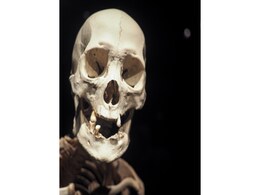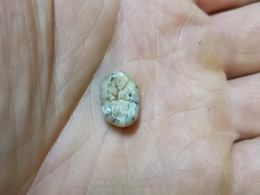Denisovans
- All
- News
-

Neanderthal Blood Protein Incompatibilities May Have Contributed to Extinction
- Thursday January 30, 2025
- Written by Gadgets 360 Staff
Research indicates that genetic differences in Neanderthal blood proteins may have played a role in their extinction. Scientists discovered that Neanderthals had a rare RhD blood type, which was incompatible with the blood types of Denisovans and Homo sapiens. This incompatibility could have led to hemolytic disease in mixed-species offspring, resu...
-
 www.gadgets360.com
www.gadgets360.com
-

Homo Juluensis Discovered: A New Chapter in Middle Pleistocene Human Evolution
- Tuesday December 3, 2024
- Written by Gadgets 360 Staff
A newly discovered species, Homo juluensis, has been identified from fossils found in China, dating back between 220,000 and 100,000 years ago. The fossils, unearthed at Xujiayao and Xuchang, feature large skulls with a unique blend of Neanderthal, Denisovan and modern human traits. Researchers, including Christopher Bae from the University of Hawa...
-
 www.gadgets360.com
www.gadgets360.com
-

'Large Head People': Mysterious Ancient Humans With Oversized Brains Discovered
- Monday December 2, 2024
- Science | Edited by Ritu Singh
The emergence of the Large Head People has raised fundamental questions about human evolution, diversity, and migration patterns.
-
 www.ndtv.com
www.ndtv.com
-

Ancient Tajikistan Rock Shelter Sheds Light on 130,000-Year-Old Human Migration
- Tuesday November 12, 2024
- Written by Gadgets 360 Staff
A newly discovered rock shelter in Tajikistan’s Zeravshan Valley shows evidence of repeated human occupation over 130,000 years. The site contains artifacts from Neanderthals, Denisovans, and Homo sapiens, suggesting it may have been a migration hub. Archaeologists believe the Inner Asian Mountain Corridor (IAMC) in Central Asia served as a migra...
-
 www.gadgets360.com
www.gadgets360.com
-

Here's How Tibetan Women's Adapts to Thin Air in Extreme High Altitudes
- Wednesday October 23, 2024
- Written by Gadgets 360 Staff
Tibetan women living on the Tibetan Plateau have developed extraordinary adaptations to thrive in extreme high altitudes. New research from Case Western Reserve University highlights unique physiological traits, including blood and heart characteristics that optimise oxygen delivery. These adaptations are linked to the EPAS1 gene, passed down from ...
-
 www.gadgets360.com
www.gadgets360.com
-

Child's Tooth, 1,30,000 Years Old, Offers Clues To Ancient Human Relative
- Wednesday May 18, 2022
- World News | Agence France-Presse
A child's tooth at least 130,000 years old found in a Laos cave could help scientists uncover more information about an early human cousin, a study said on Tuesday.
-
 www.ndtv.com
www.ndtv.com
-

A Mysterious Human Ancestor Gets A Face And A Body
- Friday September 20, 2019
- Science | Ben Guarino, The Washington Post
No one has locked eyes with a Denisovan for tens of thousands of years. These mysterious humans left behind few bones, unlike their close Neanderthal relatives, on their way to extinction. All the remains confirmed to be Denisovan - part of a pinkie finger, half a jawbone, some teeth - could rest comfortably in a shoe box.
-
 www.ndtv.com
www.ndtv.com
-

DNA From 70,000-Year-Old Pinky Bone Used To Reconstruct Elusive Skeleton
- Thursday September 19, 2019
- Science | Reuters
Researchers in Israel say they have reconstructed the skeleton of a pre-historic human from a long-extinct and elusive species using DNA found in the pinky bone of a 13-year-old girl who died 70,000 years ago.
-
 www.ndtv.com
www.ndtv.com
-

Jaw From Mysterious Human Species Shows Early Embrace Of The High Life
- Thursday May 2, 2019
- Science | Ben Guarino, The Washington Post
Denisovan and Neanderthals share a lineage that branched off from the ancestor of modern humans about 700,000 years ago. The two sister species then split apart about 300,000 years later.
-
 www.ndtv.com
www.ndtv.com
-

Rare Primitive Humans May Have Made Tools, Jewellery: Study
- Thursday January 31, 2019
- World News | Agence France-Presse
A rare species of primitive human roamed the forests of Eurasia 200,000 years ago and may have made tools and even jewellery, according to new research published Wednesday.
-
 www.ndtv.com
www.ndtv.com
-

Humans Bred With This Mysterious Species More Than Once, New Study Shows
- Friday March 16, 2018
- World News | Ben Guarino, The Washington Post
We rarely portray Neanderthals, our close relatives, as telegenic. Museum exhibits give them wild tangles of hair, and Hollywood reduces them to grunting unsophisticates.
-
 www.ndtv.com
www.ndtv.com
-

Neanderthal Blood Protein Incompatibilities May Have Contributed to Extinction
- Thursday January 30, 2025
- Written by Gadgets 360 Staff
Research indicates that genetic differences in Neanderthal blood proteins may have played a role in their extinction. Scientists discovered that Neanderthals had a rare RhD blood type, which was incompatible with the blood types of Denisovans and Homo sapiens. This incompatibility could have led to hemolytic disease in mixed-species offspring, resu...
-
 www.gadgets360.com
www.gadgets360.com
-

Homo Juluensis Discovered: A New Chapter in Middle Pleistocene Human Evolution
- Tuesday December 3, 2024
- Written by Gadgets 360 Staff
A newly discovered species, Homo juluensis, has been identified from fossils found in China, dating back between 220,000 and 100,000 years ago. The fossils, unearthed at Xujiayao and Xuchang, feature large skulls with a unique blend of Neanderthal, Denisovan and modern human traits. Researchers, including Christopher Bae from the University of Hawa...
-
 www.gadgets360.com
www.gadgets360.com
-

'Large Head People': Mysterious Ancient Humans With Oversized Brains Discovered
- Monday December 2, 2024
- Science | Edited by Ritu Singh
The emergence of the Large Head People has raised fundamental questions about human evolution, diversity, and migration patterns.
-
 www.ndtv.com
www.ndtv.com
-

Ancient Tajikistan Rock Shelter Sheds Light on 130,000-Year-Old Human Migration
- Tuesday November 12, 2024
- Written by Gadgets 360 Staff
A newly discovered rock shelter in Tajikistan’s Zeravshan Valley shows evidence of repeated human occupation over 130,000 years. The site contains artifacts from Neanderthals, Denisovans, and Homo sapiens, suggesting it may have been a migration hub. Archaeologists believe the Inner Asian Mountain Corridor (IAMC) in Central Asia served as a migra...
-
 www.gadgets360.com
www.gadgets360.com
-

Here's How Tibetan Women's Adapts to Thin Air in Extreme High Altitudes
- Wednesday October 23, 2024
- Written by Gadgets 360 Staff
Tibetan women living on the Tibetan Plateau have developed extraordinary adaptations to thrive in extreme high altitudes. New research from Case Western Reserve University highlights unique physiological traits, including blood and heart characteristics that optimise oxygen delivery. These adaptations are linked to the EPAS1 gene, passed down from ...
-
 www.gadgets360.com
www.gadgets360.com
-

Child's Tooth, 1,30,000 Years Old, Offers Clues To Ancient Human Relative
- Wednesday May 18, 2022
- World News | Agence France-Presse
A child's tooth at least 130,000 years old found in a Laos cave could help scientists uncover more information about an early human cousin, a study said on Tuesday.
-
 www.ndtv.com
www.ndtv.com
-

A Mysterious Human Ancestor Gets A Face And A Body
- Friday September 20, 2019
- Science | Ben Guarino, The Washington Post
No one has locked eyes with a Denisovan for tens of thousands of years. These mysterious humans left behind few bones, unlike their close Neanderthal relatives, on their way to extinction. All the remains confirmed to be Denisovan - part of a pinkie finger, half a jawbone, some teeth - could rest comfortably in a shoe box.
-
 www.ndtv.com
www.ndtv.com
-

DNA From 70,000-Year-Old Pinky Bone Used To Reconstruct Elusive Skeleton
- Thursday September 19, 2019
- Science | Reuters
Researchers in Israel say they have reconstructed the skeleton of a pre-historic human from a long-extinct and elusive species using DNA found in the pinky bone of a 13-year-old girl who died 70,000 years ago.
-
 www.ndtv.com
www.ndtv.com
-

Jaw From Mysterious Human Species Shows Early Embrace Of The High Life
- Thursday May 2, 2019
- Science | Ben Guarino, The Washington Post
Denisovan and Neanderthals share a lineage that branched off from the ancestor of modern humans about 700,000 years ago. The two sister species then split apart about 300,000 years later.
-
 www.ndtv.com
www.ndtv.com
-

Rare Primitive Humans May Have Made Tools, Jewellery: Study
- Thursday January 31, 2019
- World News | Agence France-Presse
A rare species of primitive human roamed the forests of Eurasia 200,000 years ago and may have made tools and even jewellery, according to new research published Wednesday.
-
 www.ndtv.com
www.ndtv.com
-

Humans Bred With This Mysterious Species More Than Once, New Study Shows
- Friday March 16, 2018
- World News | Ben Guarino, The Washington Post
We rarely portray Neanderthals, our close relatives, as telegenic. Museum exhibits give them wild tangles of hair, and Hollywood reduces them to grunting unsophisticates.
-
 www.ndtv.com
www.ndtv.com












